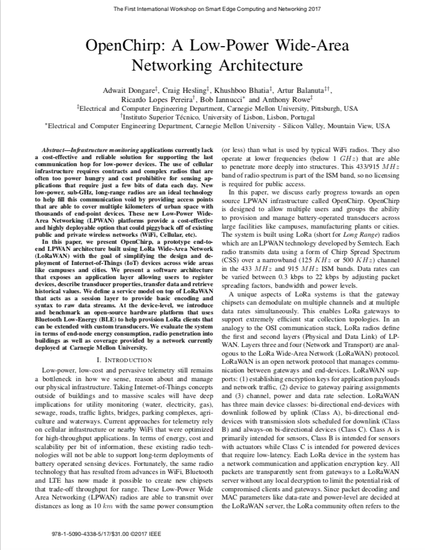
Article
OpenChirp: A Low-Power Wide-Area Networking Architecture
IEEE International Conference on Pervasive Computing and Communications Workshops (PerCom Workshops)
(2017)
Abstract
Infrastructure monitoring applications currently lack a cost-effective and reliable solution for supporting the last communication hop for low-power devices. The use of cellular infrastructure requires contracts and complex radios that are often too power hungry and cost prohibitive for sensing applications that require just a few bits of data each day. New low-power, sub-GHz, long-range radios are an ideal technology to help fill this communication void by providing access points that are able to cover multiple kilometers of urban space with thousands of end-point devices. These new Low-Power Wide-Area Networking (LPWAN) platforms provide a cost-effective and highly deployable option that could piggyback off of existing public and private wireless networks (WiFi, Cellular, etc). In this paper, we present OpenChirp, a prototype end-to-end LPWAN architecture built using LoRa Wide-Area Network (LoRaWAN) with the goal of simplifying the design and deployment of Internet-of-Things (IoT) devices across wide areas like campuses and cities. We present a software architecture that exposes an application layer allowing users to register devices, describe transducer properties, transfer data and retrieve historical values. We define a service model on top of LoRaWAN that acts as a session layer to provide basic encoding and syntax to raw data streams. At the device-level, we introduce and benchmark an open-source hardware platform that uses Bluetooth Low-Energy (BLE) to help provision LoRa clients that can be extended with custom transducers. We evaluate the system in terms of end-node energy consumption, radio penetration into buildings as well as coverage provided by a network currently deployed at Carnegie Mellon University.
Keywords
- LP-WAN,
- LoRa,
- OpenChirp,
- IoT
Disciplines
Publication Date
2017
DOI
10.1109/PERCOMW.2017.7917625
Citation Information
Adwait Dongare, Craig Hesling, Kushboo Bhatia, Artur Balanuta, et al.. "OpenChirp: A Low-Power Wide-Area Networking Architecture" IEEE International Conference on Pervasive Computing and Communications Workshops (PerCom Workshops) (2017) p. 569 - 574 Available at: http://works.bepress.com/bob/38/
